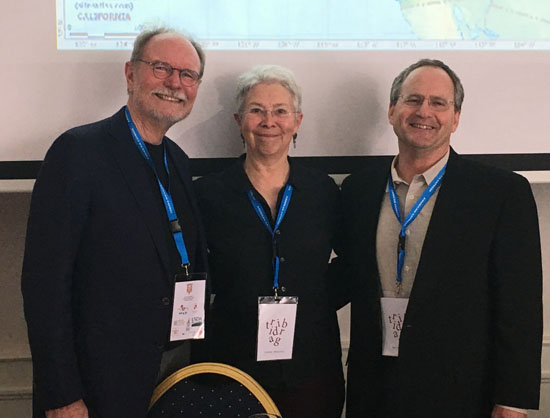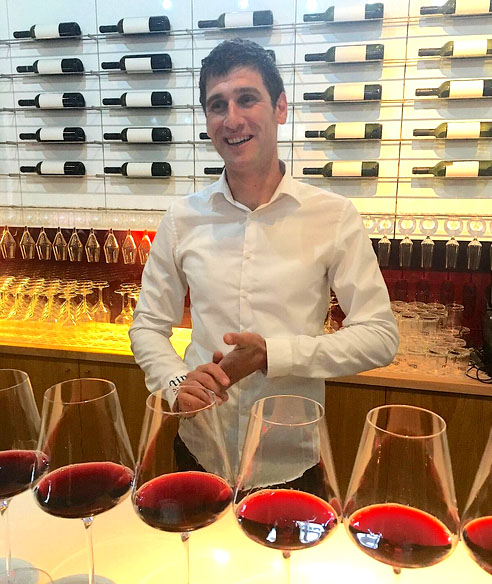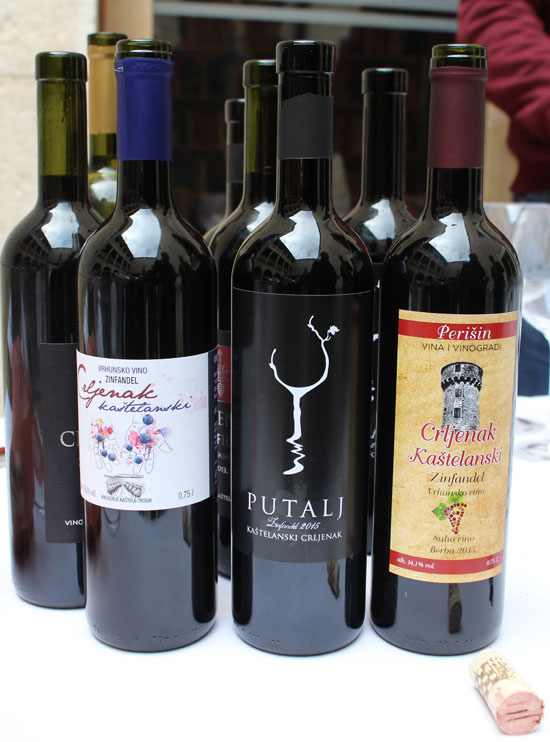story and photos by Elyse Glickman
While Croatia’s wine growing regions may not be as well-known internationally as Napa and Sonoma, fascinating revelations at “I Am Tribidrag,” a first-ever global conference in the fashionable seaside town of Split may help change all that.
Sommeliers, scholars, buyers, and wine aficionados in attendance from around the world were witness to a “grape” family reunion built upon two decades of research helmed by Dr. Carole Meredith, a now-retired grape geneticist from U.C. Davis, and Dr. Edi Maletić of University of Zagreb to find the varietal begetting Zinfandel, Italian Primitivo, Dalmatian Crljenak Kaštelanski, and others.

Sonoma-based David Gates, Vice President of Vineyard Operations
at Ridge Vineyards at the conference.
This search leading to Tribidrag, indigenous to several wine-growing areas around Split and the Dalmation Coast, was so intensive that it would surely impress the folks at Ancestry.com. According to Dr. Meredith’s lively retelling of her search and collaboration with the University of Zagreb’s Dr. Ivan Pejić, Professor of Plant Breeding, and Maletić starting in 1997, it employed an exhaustive run of DNA tests, plant cuttings, and much trial and error.
“Zinfandel is one of the earliest European grapes to be brought to California, and for generations, nobody knew where this varietal came from,” explained Dr. Meredith during conference’s opening ceremony. “This story is not just about science. This undertaking was so much more, as it was also about also about history—and from a California perspective, there was a big hole in our viticulture history that this endeavor helped us to fill.”
A video shown prior to Dr. Meredith’s speech featured 94 year-old Napa winemaker Miljenko “Mike” Grgich proclaiming Zinfandel—the grape putting California winemaking on the map—was “one of California’s first European immigrants.” Sonoma-based David Gates, Vice President of Vineyard Operations at Ridge Vineyards, expanded on Grgich’s statements with a historic rundown of how what became recognized as Zinfandel made its way from Europe to North America in the early 19th century, its journey to California, and its presence in American viticulture during the 20th century.

After a side-by-side flight tasting of five California Zinfandel wines (Carol Shelton 2014 Monga Zin, Michael David Winery 2014 Earthquake, Ravenswood 2013 Old Hill Ranch, Ridge 2014 Lytton Springs and Turley 2014 Judge Bell), Joel Peterson, winemaker and founder of Sonoma’s Ravenswood Winery, weighed in on his involvement in the conference and his projections of the impact of information discussed at the conference.
Peterson (aka “the godfather of Zinfandel,” stemming from his work from the 1970s on) detailed that he was approached by Gates not long after Gates was approached by the “I Am Tribidrag” people. Gates invited him to lend his expertise to the conference and co-preside over the tasting. He also shared Gates’ admiration for Dr. Meredith and her dedication to uncover Zinfandel’s roots and DNA, as well as the opportunity to spend a week with Croatian winemakers and exploring these origins himself.

“This conversation we’re having today adds to the story of what we as winemakers and what sommeliers, beverage managers and buyers can tell the customers about California Zinfandel,” he said. “We can now tell them that this was the wine Renaissance-era Venetians enjoyed at those fabled masked balls, and how [the variety] made its way to Southern Italy as Primitivo. The discoveries covered at ‘I Am Tribidrag’ ties Zinfandel back to an ancient grape varietal which has survived and is still in use today. It adds value and texture to what we do as winemakers.”
Peterson hoped the information shared at this first conference would trickle out to consumers via print and online media, as well as through sommeliers who now have something new about Zinfandel they can share with customers during table-side stories that bring customers in to their venues. This includes Millennial-generation wine drinkers who he observes take special interest in what they are drinking, whether what they order is a fine wine, a craft beer, or a craft cocktail.
“This is a generation of consumers who are very well educated,” he continues. “They appreciate the complexity of things. As winemakers, we know instinctively what makes wine interesting to people, whether they are older casual consumers who drink wine because it is an enjoyable thing to do, or are among those Millennial and Gen-X who want the whole story behind a given varietal. [Knowledge of Tribidrag] gives Zinfandel value and texture beyond the just what’s in the [physical] product itself.”
See the complementary story on this conference in the digital edition of the June-July Somm Journal at this link. Ed.
A Few “Grape” Spots to Visit in Croatia
While Croatia is a rising star in the European consumer gastronomy and eno-tourism industry, it is also becoming an increasingly important place for sommeliers and industry pros looking to enrich their knowledge on internationally popular varietals like Zinfandel and Primitivo. There are also several destinations where they can broaden the scope of their wine lists to include Tribidrag and wines with other Croatian varietals such as robust red Plavac Mali and delicate white Grk.
Stina Winery, Bol, Brač Island
stina-vino.hr/en/about-us
With vineyards emerging from rocky hillsides and a 1903 winery building whose entrance appears to touch the sea on a stormy day, one can expect the wines from Stina (which translates to “stone,” and is inspired the limestone that impacts aromas and flavors) to be pretty dramatic. A session inside the sleek tasting area does not disappoint, with samplings of recent bottlings of Stina Pošip, Plavac Mali Rose, and Plavac Mali. While Stina’s wine-making operations are outfitted with the latest equipment, the historic legacy of the area’s wine production and century-old “First Dalmatian Wine Cooperative” are nicely preserved.
Kraljevski Vinogradi, Petrčane
kraljevski-vinogradi.hr/en
Although this winery hovers almost directly above beachy seaside Zarar, the lush Kraljevski Vinogradi (translated: “Royal Vineyards”) feels as if it occupies another world. It may be because it was a site of an 11th century monastery where the monks were devoted to viticulture. Although the vineyards nurturing Dalmatian varietals Pošip, Plavac Mali and Crljenak (a very close Zinfandel cousin) were planted in 2009, many viticulture traditions are followed. The restaurant, featuring simple, hearty local fare, serves dinners that are the perfect foils for its various wine offerings.
SPLIT
Hotel Park/Restaurant Split
Hotelpark-split.hr
The “Art Deco” hotel, opened in 1921, is not just a fantastic place for a small conference (such as the “I Am Tribidrag” conference) but also a picturesque place to pair selections from its wine list with a wide array of dishes from the Dalmatians and other reaches of Croatia.
Brasserie No.7
brasserieon7.com
A cheerful waterfront establishment featuring contemporary, light iterations of Dalmatian dishes, which can be paired with local wines by the bottle, glass, or in delightful cocktails with seasonal fruits.
Konoba Matoni
ma-toni.com/en
The cozy, tavern-like wine shop and restaurant provides a nice counter balance to the resort-y Hotel Park across the street. Expect exceptional pastas, crisp and refreshing salads, and even several vegan and vegetarian dishes. All pair nicely with the mostly Dalmatian wine list selections and craft beers.
Bokeria
facebook.com/bokeriasplit
The family-owned restaurant puts a contemporary Catalonian/Spanish twist on the Dalmatian food-and-wine experience with a variety of tapas-sized nibbles and larger, meant-to-share main courses.
Uje Oil Bar
www.oilbar.hr
This local favorite (which also has a Zegreb location and others) features changing daily specials as well as charcuterie, artisanal cheeses and marinated fish. However, it’s the olive oils and other condiments for sale and served with the food that provides inspiration on how to create one’s own wine tasting with Dalmatian wines and different foods.
Marcvs Marvlvs Library Jazz Bar
www.facebook.com/marvlvs
It is not only a shooting site for Game of Thrones, but also the vision of Argentine-born Croatian Tin Bokanić, blending Croatian wines, live and dj-ed music, and cool ambiance to spare.
ZABREB
Hotel Esplanade
esplanade.hr
This luxury grand hotel, built in 1925, has all the earmarks of the opulent Orient-Express, as Zagreb was a stop on the fabled journey. Chef de cuisine Ana Grgic anchors the hotel’s three restaurants, including the aptly named Zinfandel’s. While its cuisine has merited the restaurant numerous awards, it is Sommelier Ivan Sneler who make it a must-visit for wine professionals and enthusiasts alike. Sneler, who started with the hotel as a waiter in the 1980s, fell in love with the art of winemaking after viewing a presentation held by a prominent California winemaker staying at the Esplanade. In 1993, he convinced the Food & Beverage Manager to allow him to study to become a sommelier and eventually take over the mantle. After completing his extensive training, Sneler became the very first professional sommelier in Croatia.
Vinoteka & Wine Bar Bornstein
bornstein.hr
In describing this wine shop and tasting room, the words “iconic” and “local institution” get bandied around a lot in reviews. Over-used descriptors aside, what makes this a can’t-miss experience for professionals and enthusiasts is the passion Adelaide, Australian-bred Ivan Srpek puts into bringing the 200 year-old arched basement alive. To describe his knowledge of wine as “encyclopedic” is one thing, but its his enthusiasm and charm that makes learning about small- and medium-sized Croatian wineries and varietals a pleasure.
Pod Zidom
facebook.com/PodZidom
This superb restaurant takes farm-to-field literally, with an ever-changing roster of appetizers and mains crafted fresh groceries brought directly from neighboring Dolač market. Astute waiters familiar with Croatian’s wine growing regions (Zagreb Hills, Istria, Dalmatia, and Slavonia) and varietals expertly suggest food-wine pairings with little pretention and lots of charm.
Truly Croatia Tours
trulycroatia.com
These tours aim to show you the uniqueness and beauty of Croatia. It’s a great vacation spot winter or summer. They have land and sea tours, and they also give you the ability to customize your tour and create a dream itinerary. Check out their website for pricing and availability.
